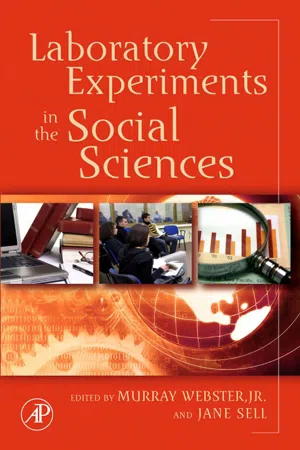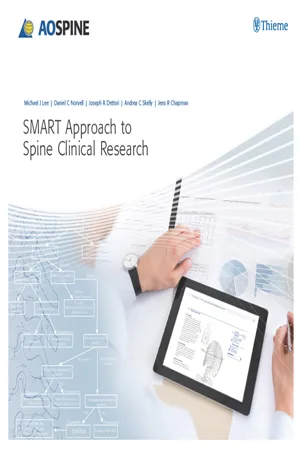Mathematics
Bias in Experiments
Bias in experiments refers to systematic errors or inaccuracies that can occur due to flaws in the design, conduct, or analysis of the experiment. These biases can lead to misleading results and conclusions. It is important to identify and minimize biases in order to ensure the validity and reliability of the experimental findings.
Written by Perlego with AI-assistance
3 Key excerpts on "Bias in Experiments"
- Murray Webster, Jane Sell(Authors)
- 2007(Publication Date)
- Academic Press(Publisher)
Thus, student expectations had an impact on rat performance. Another kind of experimenter bias occurs when subjects try to be helpful in the experiment and act in ways to confirm what they believe to be the hypothesis (correctly or otherwise). I address both forms in more detail later. 74 Laboratory Experiments in the Social Sciences 5 Strictly speaking, statistical regression to the mean can be caused by numerous factors, includ-ing chance fluctuations of subjects’ true score values or random measurement error associated with the instrument. Despite these threats to internal validity, the logic of experimental design provides a straightforward and powerful solution to eliminate confounds. Next, I turn to these solutions. VII. USING EXPERIMENTAL DESIGN TO RESOLVE PROBLEMS OF INTERNAL VALIDITY The last mentioned threat to internal validity, experimenter effects, is perhaps the easiest to prevent. In principle, experimenter effects occur because (1) subjects attempt to confirm or disconfirm the experimental hypothesis, or (2) experimenters unintentionally influence subject behavior. The solution for both problems is to use blinding techniques. A single-blind experiment is one in which the subject does not know the true hypothesis under investigation. If subjects do not know the hypothesis, they cannot act in ways to confirm or disconfirm that hypothesis. Researchers use a variety of techniques—from simply withholding information to outright deception—to prevent subjects from knowing the hypothesis. Single-blind techniques also prevent other kinds of subject-expectancy biases. For instance, medical research has shown that ingesting an inert substance (such as sugar or starch) can make some patients feel better simply because they believe they should feel better. Placebo effects are detected by keeping some subjects blind to the experimental treatment. A more stringent way to prevent experimenter effects is to use a double-blind technique.- eBook - PDF
Dealing with Data
The Commonwealth and International Library: Physics Division
- Arthur J. Lyon, W. Ashhurst(Authors)
- 2013(Publication Date)
- Pergamon(Publisher)
CHAPTER 1 EXPERIMENTAL ERRORS 1. ERROR AND UNCERTAINTY IN MEASUREMENTS The data, i.e. the numerical results of measurements, with which we have to deal in the physical sciences are invariably subject in some degree to errors and uncertainty. By errors, in this context, we do not mean mistakes. Examples of mistakes in experimental work are of mis-readings of a scale, faulty ad-justments, careless handling of equipment, failure to take essen-tial precautions, arithmetic slips in calculation, and so forth. But all of these are faults which can be eliminated or at least reduced to a minimum by care, practice, and experience. A mistake is a departure from the correct, prescribed, or intended procedure for the experiment; an error, on the other hand, in the context of measurements, means a departure of the measured value from the true value which occurs even when the prescribed procedure has been followed correctly. 1 Such departures, experimental errors as they are called, can arise from many sources, including imperfections of the equip-ment and effects of the surrounding physical conditions. There are, in fact, many kinds of experimental error, and the follow-ing sections (§§ 2-10) will attempt to describe the most impor-tant kinds and to illustrate them in relation to simple measure-ments such as all students in the physical sciences will common-ly meet. Often experimental errors can be corrected or reduced in magnitude by improvements of technique, but liability to such t For a discussion of some ambiguities in this definition see § 21.1. 2 DEALING WITH DATA errors can never be eliminated entirely. It is therefore impor-tant to be able to assess the magnitude of the experimental error liable to be present in the result of a measurement. The methods of doing so will be dealt with in later chapters, but some brief preliminary comments may be useful. There are, in fact, two principal modes of assessment in common use. - eBook - PDF
- Michael J. Lee, Daniel C. Norvell, Joseph R. Dettori, Andrea C Skelly, Jens Chapman(Authors)
- 2013(Publication Date)
- AO Publishing, Davos(Publisher)
This is often referred to as internal validity, which is directly related to how much a study is free from bias. An exposure is a potential causal characteristic and can refer to a treatment (eg, surgery, drugs), a behavior (eg, smoking), a trait (eg, sex) or, in the simplest sense, anything one may be exposed to (eg, airborne illness). An exposure is sometimes referred to in research as the “inde-pendent variable” since it is the factor being varied or manipu-lated in a study and which determines the change in the dependent variable (ie, outcomes). Bias is a systematic error or deviation from the truth. It results in either an overestimate or an underestimate of the true ef-fect of an exposure. Said another way, bias is a lack of internal validity or an incorrect or distorted assessment of the associa-tion between an exposure and an effect in a target population. The degree to which one can place confidence in the results of a study depends greatly on whether biases have been accounted for and the necessary steps have been taken to diminish the impact of biases. Bias can be introduced into a study in a number of ways and each stage of the trial process is prone to a specific type of bias ( Fig 8-1 ). Some of the most common and discernible causes of bias are summarized in Table 8-1 . They include: • Selection bias—biased assignment to comparison groups • Attrition bias—biased occurrence and management of loss to follow-up and deviations from protocol • Performance bias—biased difference in delivery of care and preferential provision of additional care (other than the treatment of interest) • Measurement/detection bias—biased outcome assessment or classification • Reporting bias—biased reporting of significant or favorable results As you will see, mitigating the effects of bias depends greatly on the adequacy of the study design and the degree of control exercised in gathering data. Fig 8-1 Areas of potential bias within the study architecture.
Index pages curate the most relevant extracts from our library of academic textbooks. They’ve been created using an in-house natural language model (NLM), each adding context and meaning to key research topics.


